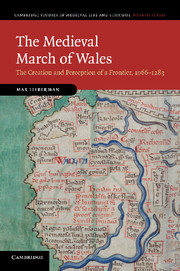Book contents
- Frontmatter
- Contents
- List of maps
- List of tables and illustration
- Preface
- List of abbreviations
- INTRODUCTION
- 1 A BORDER REGION?
- 2 THE MAKING OF A BORDER ARISTOCRACY
- 3 WARFARE AND DIPLOMACY
- 4 THE EXTENT AND NATURE OF THE MILITARY FRONTIER
- 5 THE MILITARIZATION OF SOCIETY
- 6 THE SHAPING OF ADMINISTRATIVE TERRITORIES
- 7 THE BORDER LORDSHIPS AND THE ENGLISH STATE
- CONCLUSION
- Select bibliography
- Index
CONCLUSION
Published online by Cambridge University Press: 06 July 2010
- Frontmatter
- Contents
- List of maps
- List of tables and illustration
- Preface
- List of abbreviations
- INTRODUCTION
- 1 A BORDER REGION?
- 2 THE MAKING OF A BORDER ARISTOCRACY
- 3 WARFARE AND DIPLOMACY
- 4 THE EXTENT AND NATURE OF THE MILITARY FRONTIER
- 5 THE MILITARIZATION OF SOCIETY
- 6 THE SHAPING OF ADMINISTRATIVE TERRITORIES
- 7 THE BORDER LORDSHIPS AND THE ENGLISH STATE
- CONCLUSION
- Select bibliography
- Index
Summary
The introduction to this book proposed that the border between Shropshire and Powys provides a showcase for studying the creation and perception of the medieval March of Wales. That border shifted strikingly little during the two centuries or so which elapsed between the Norman conquest of England in 1066 and the English conquest of Wales in 1282–3. It therefore contrasted sharply with certain parts of Wales, particularly the north, south and west coasts, where the Normans and the English made spectacular territorial gains and often suffered equally spectacular losses. But, while the medieval Shropshire–Powys border remained remarkably fixed in terms of its geographical position, the way in which it was conceptualized changed dramatically. As far as we can tell, it was the Welsh borders of Shropshire which from 1166 inspired a new fashion for the term Marchia Wallie, even though the compact border honors clustered around the Severn gap were established mostly on English rather than Welsh territory. However, by the fourteenth century, the category Marchia Wallie routinely included the Shropshire ‘March’ as well as the conquest lordships in south Wales. Thus, at first there was a discrepancy between the medieval and the modern concepts of the March of Wales. More than a century elapsed before the medieval concept of the March came to routinely embrace the compact honors on the Anglo-Welsh borders as well as the conquered parts of Wales. The preceding chapters have sought to explain this conceptual change.
- Type
- Chapter
- Information
- The Medieval March of WalesThe Creation and Perception of a Frontier, 1066–1283, pp. 246 - 263Publisher: Cambridge University PressPrint publication year: 2010



